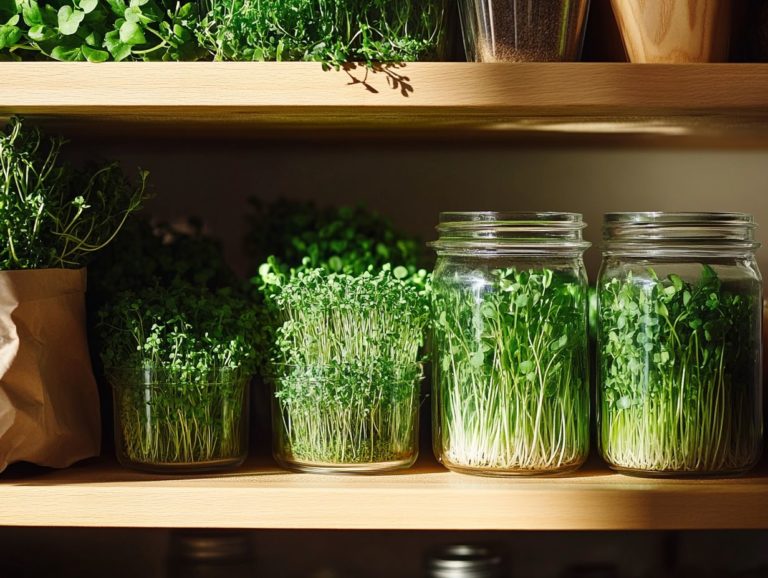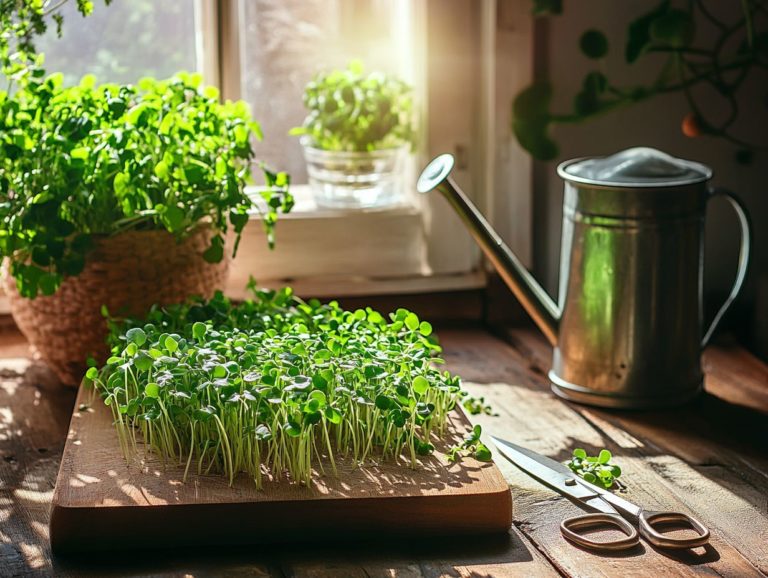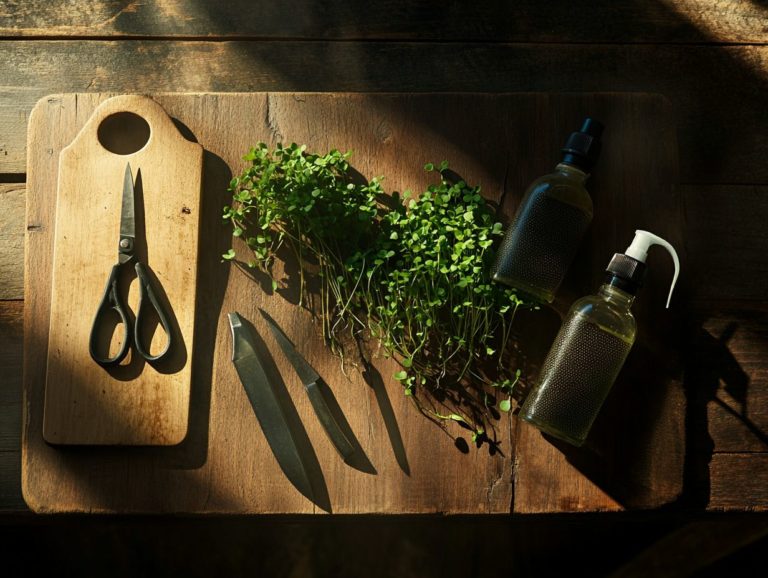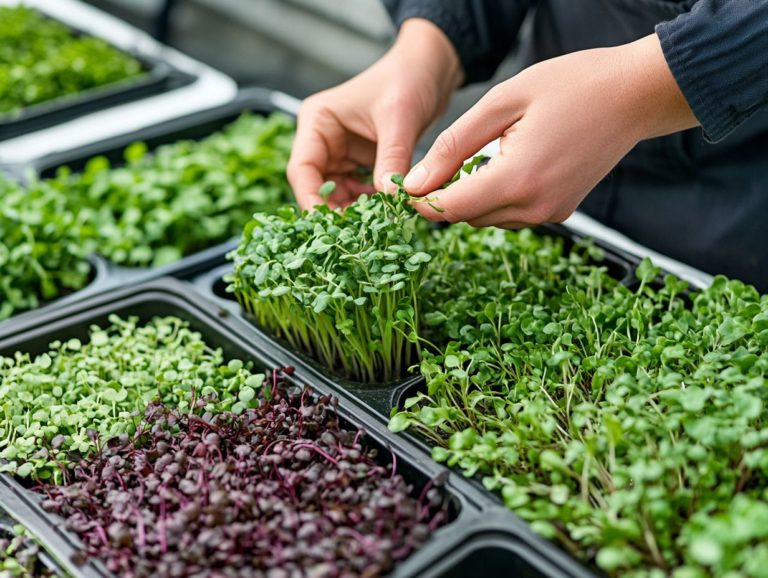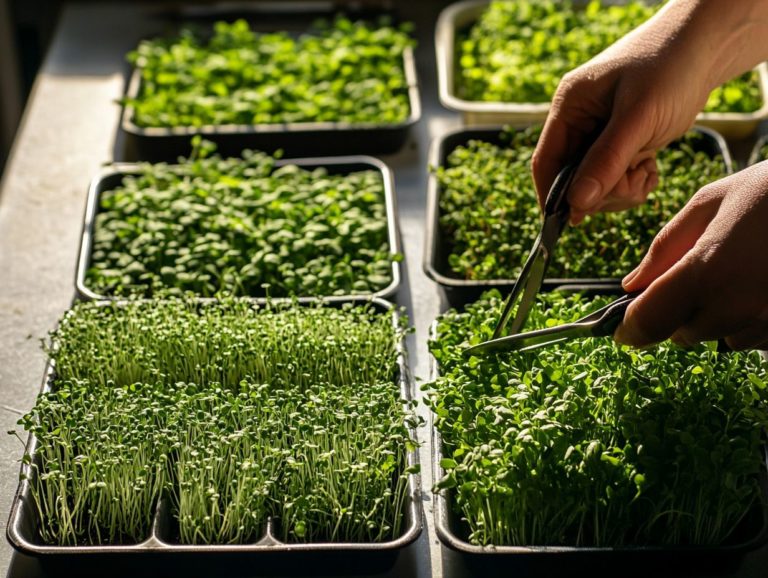The Best Substrates for Microgreen Growing and Harvest
Microgreens aren’t just a trend; they’re tiny flavor explosions that add color and nutrition to your meals! Their popularity has skyrocketed, not only for their vibrant flavors and colors but also for their remarkable nutritional benefits and versatility as a growing medium.
Whether you re a seasoned gardener or just dipping your toes into gardening, growing these tiny powerhouses requires more than simply seeds and water. Selecting the right growing medium, such as organic options like potting soil or coco coir, is essential.
This article delves into the various growing mediums available for microgreens, including brands like Pro-Mix and Happy Frog. We will guide you through their preparation, maintenance, and best practices for harvesting.
Choosing the ideal foundation, including options like TerraFibre and Rockwool, can transform your microgreen growing experience into something truly exceptional!
Contents
- Key Takeaways:
- Choosing the Right Growing Medium for Microgreens
- Types of Growing Mediums for Microgreens
- Preparing and Maintaining Substrates for Microgreens
- Harvesting Microgreens
- Frequently Asked Questions
- What are the top substrates to grow your microgreens successfully?
- Why is coco coir a popular substrate for microgreens?
- Can I use regular soil as a substrate for microgreen growing?
- What is the best substrate for growing microgreens in a hydroponic system?
- How do I prepare the substrate for microgreen growing?
- Can I reuse the substrate for multiple microgreen harvests?
Key Takeaways:
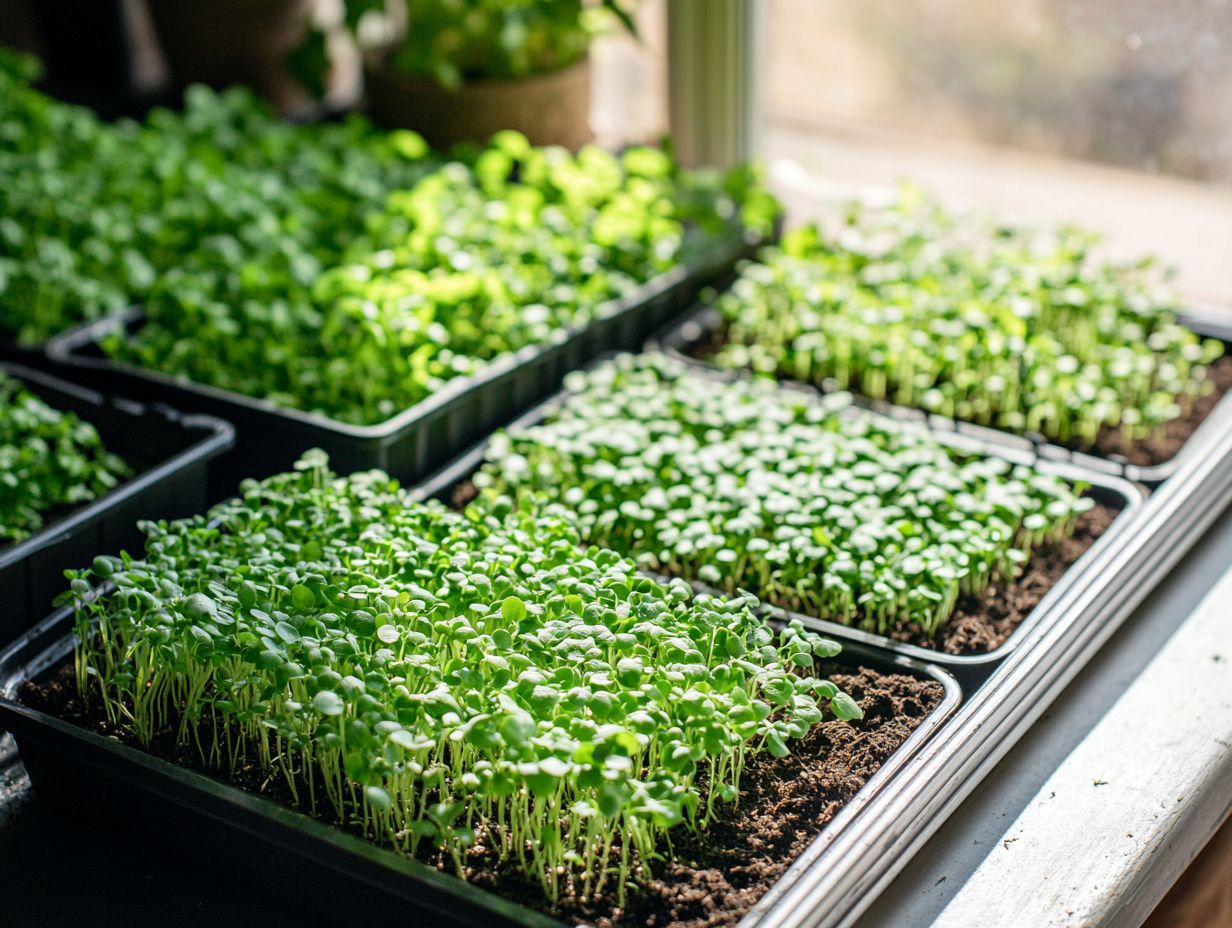
- Choose the right growing medium for microgreens based on water retention, drainage, and nutrient needs.
- Soil-based mediums like potting soil and peat are popular and cost-effective, while hydroponic options like hemp mats and Rockwool offer more control over nutrients and moisture.
- To ensure successful growth and harvest, prepare and maintain your chosen medium properly and harvest at the optimal time using the right techniques and storage methods.
Why Should You Grow Microgreens? Discover Their Benefits!
Microgreens are the young, edible wonders you can harvest just after the first true leaves have unfurled, usually within 7 to 21 days following germination. With a delightful variety of seed options like sunflowers, pea shoots, and radishes, they re highly coveted for their robust flavors and impressive nutrient density, making them an ideal choice for anyone passionate about home gardening.
These tiny powerhouses are loaded with vitamins, minerals, and antioxidants, often boasting higher concentrations than their fully grown counterparts. Whether you choose to grow them indoors or outdoors, microgreens are remarkably easy to cultivate, requiring minimal space and thriving in diverse environments from hydroponics (growing plants in water without soil) to traditional soil setups. This accessibility means that anyone from urban dwellers to seasoned gardeners can enjoy the satisfaction of nurturing their own nutritious greens.
They seamlessly elevate a variety of culinary creations, whether you re using them to garnish a dish or tossing them into salads, smoothies, or sandwiches. Not only do they enhance flavor, but they also provide a vital health boost to your everyday meals.
Choosing the Right Growing Medium for Microgreens
Selecting the right medium for growing microgreens is essential for achieving optimal growth, as it plays a pivotal role in drainage, water retention, and overall plant health.
There are various organic and inorganic mediums available, each presenting unique properties tailored to meet the specific needs of different microgreen varieties. Making an informed choice will set the stage for flourishing plants and a successful harvest.
Factors to Consider
When selecting a growing medium for your microgreens, consider essential factors such as drainage, water retention, plant density, and potential contamination from heavy metals. Each of these aspects can profoundly impact the growth and health of your microgreens.
For example, drainage is crucial; it affects how effectively excess water is removed from the root zone, helping to prevent root rot and encouraging healthier seedlings. Adequate water retention ensures that your microgreens have consistent moisture, vital for achieving optimal germination rates.
It s imperative to choose a medium free from heavy metals, as contamination can stifle growth and present health risks. Proper plant density also matters; overcrowding can restrict airflow and create competition for nutrients, ultimately diminishing your yield.
Taking a thoughtful approach to medium selection can establish a solid foundation for successful microgreen cultivation.
Types of Growing Mediums for Microgreens
Microgreens can be cultivated using a variety of growing mediums, each offering distinct advantages and disadvantages. These include soil-based mediums, hydroponic systems, and a selection of commercial growing mediums specifically designed to improve growing conditions.
By gaining a deeper understanding of these options, you can make an informed decision about the best medium to suit your specific needs.
Soil-based Mediums
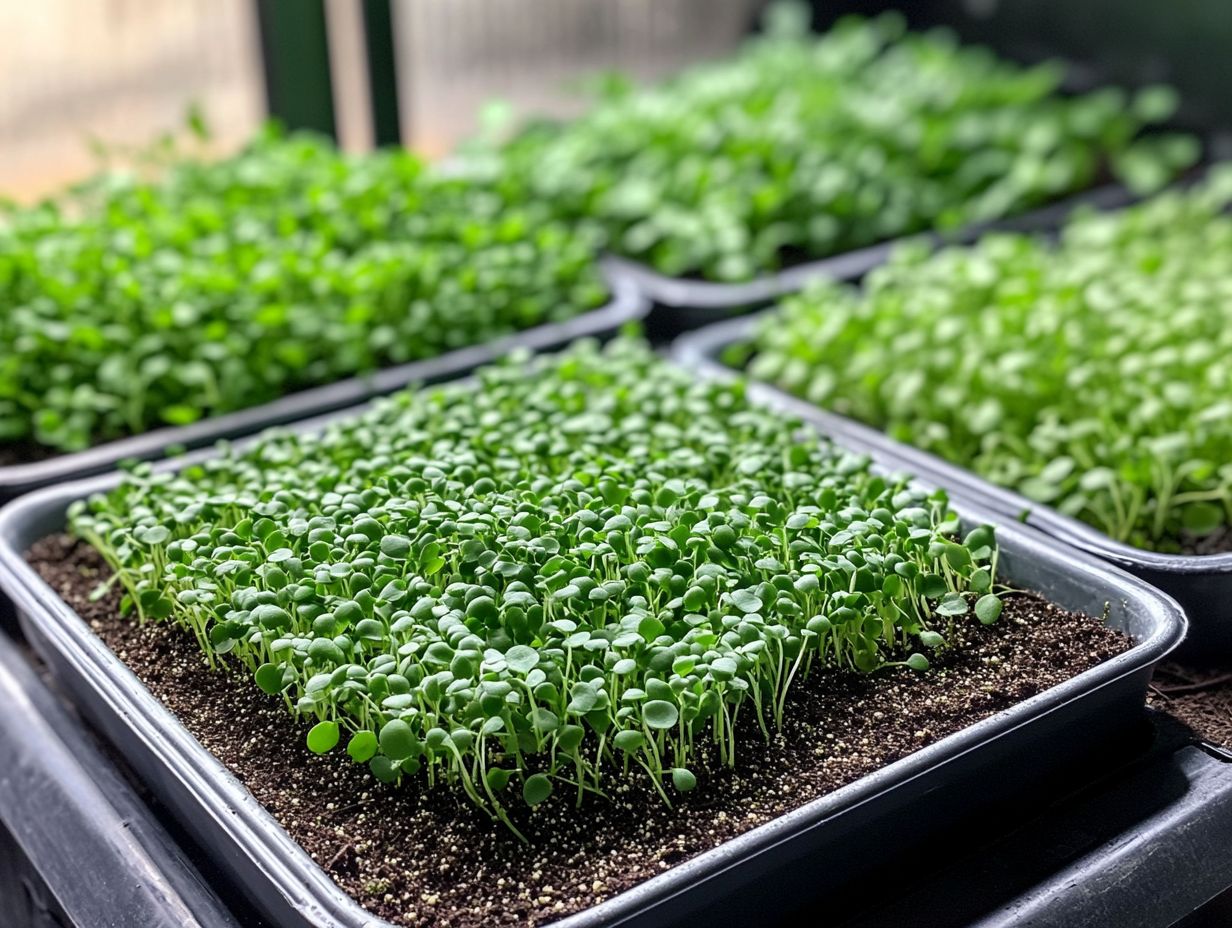
Soil-based mediums, like potting soil and blends featuring peat, perlite, and coconut fiber, create a nutrient-rich environment for your microgreens. They are favored for home microgreens because they retain moisture and supply essential nutrients necessary for healthy seedlings.
The mix of peat and coconut fiber enhances aeration and drainage, preventing overwatering while keeping the roots nicely hydrated. Perlite boosts drainage further, which is crucial for warding off fungal issues.
It’s also vital to consider the sterilization treatments for these mediums; they help eliminate harmful pathogens and pests. Properly treated mediums encourage vigorous growth and pave the way for a successful and organic microgreen harvest.
Hydroponic Mediums
Hydroponic mediums such as Rockwool, Hemp mats, and premium bamboo present a groundbreaking method for cultivating microgreens. By delivering nutrients directly through water, you can say goodbye to traditional soil!
These mediums have unique properties that create optimal growing conditions while reducing the risk of soil-borne diseases. Utilizing these materials allows for consistent moisture retention and efficient air circulation, both crucial for healthy root development.
Take Rockwool, for example; it’s well-known for its excellent drainage capabilities, preventing root rot. Hemp mats offer a sustainable and biodegradable alternative, retaining ideal moisture levels while allowing for effortless harvesting.
Bamboo brings its advantages, combining strength and eco-friendliness, enhancing drainage, and promoting robust growth. Combined, these mediums create a thriving environment for your microgreens!
Other Growing Medium Options
In addition to soil-based and hydroponic mediums, you have several intriguing options at your disposal, such as coco coir, vermiculite, cellulose, and burlap. Each of these mediums boasts unique properties that can enhance your microgreen cultivation success.
Coco coir, harvested from coconut husks, is renowned for its remarkable water retention and excellent aeration. It s a preferred choice among many growers!
Vermiculite provides a lightweight structure that improves moisture retention. It ensures your delicate seedlings receive the right amount of hydration without becoming waterlogged.
Cellulose, often derived from recycled paper products, offers an eco-friendly alternative that promotes effective aeration. It allows roots to breathe while still retaining necessary moisture.
Burlap, on the other hand, provides a biodegradable option that offers support and stability for your microgreens as they sprout. This aligns with a more sustainable farming approach.
By exploring these alternatives, you can enhance your growing conditions and potentially reap a more vibrant harvest. Don’t miss out on these fantastic options! Start experimenting with using sprouting trays for microgreens today for a healthier microgreen harvest!
Preparing and Maintaining Substrates for Microgreens
Preparing and maintaining substrates for microgreens requires a thoughtful approach. This involves essential techniques that create a thriving growing environment. Proper preparation methods and regular maintenance practices help prevent contamination and foster successful germination.
By using effective sterilization treatments, you can significantly reduce the risks posed by pathogens and pests. This ensures your microgreens flourish in their optimal conditions.
Proper Preparation Techniques
Properly preparing substrates involves a series of careful methods for the best results. Start by incorporating effective sterilization treatments, managing moisture levels, and ensuring adequate nutrient replenishment. Each of these steps is vital for creating a conducive environment for seed germination and robust plant development.
Select the right substrate whether it’s soil, coconut coir, or hydroponic mediums. Your choice sets the stage for success. Additionally, understanding the perfect light conditions for microgreens can enhance growth. Use sterilization methods like steaming or chemical treatments to eliminate harmful pathogens.
Maintaining moisture levels is critical. Your substrates should strike that perfect balance not too dry and not overly saturated. Either extreme can hinder seedling viability. Employ precise watering techniques and monitor humidity for ideal conditions.
Diligently following these preparation techniques creates a thriving environment for your microgreens, ultimately paving the way for a bountiful harvest!
Maintenance and Troubleshooting
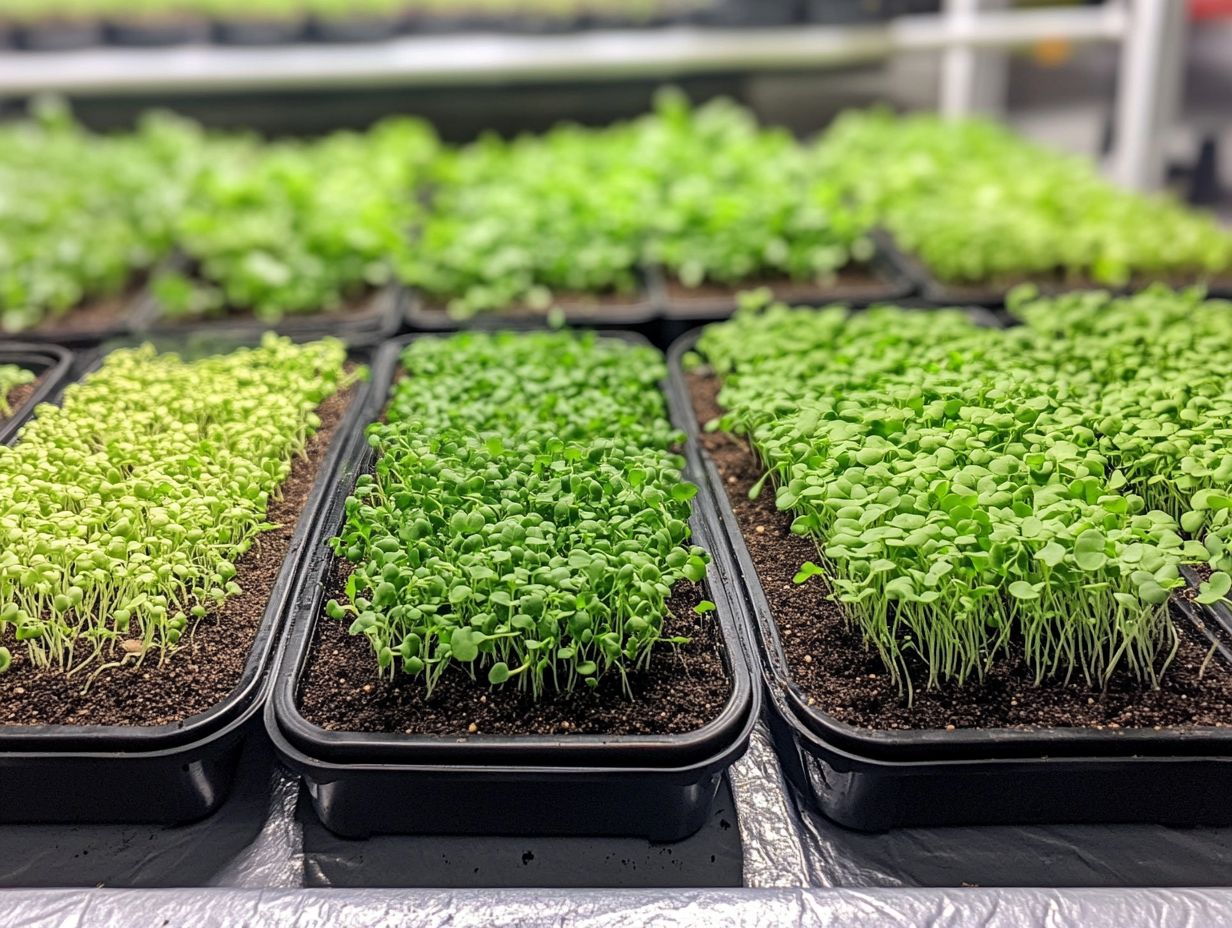
Ongoing maintenance and troubleshooting are essential for microgreen growth. Regularly check water drainage and nutrient levels to prevent issues that could compromise plant health. Address these factors promptly to ensure your microgreens thrive.
Monitor your trays for signs of water pooling or inadequate drainage. These can lead to root rot and other complications. Recognizing symptoms of nutrient deficiencies, like yellowing or stunted growth, will help you tackle challenges head-on.
Techniques such as adjusting your irrigation schedule and using high-quality fertilizers enhance nutrient availability. Keeping pH levels balanced promotes overall plant health. By implementing these strategies, you ll set yourself up for a robust microgreen harvest while minimizing potential setbacks!
Harvesting Microgreens
Harvesting microgreens at the optimal moment and using the right techniques maximize their flavor and nutritional benefits. Cut your plants just below the cotyledons (the first leaves that appear) once they reach the desired height!
Mastering the timing and methods involved significantly elevates the quality of your microgreens, ensuring they deliver the best possible taste and nutrition.
Timing and Techniques for Optimal Harvest
The key to achieving an optimal harvest of microgreens lies in your understanding of timing and the techniques you use to maximize flavor and quality. Ideally, harvest when the microgreens have developed their first true leaves but before they start to mature.
This sweet spot typically falls between 7 to 21 days, depending on the variety. For a clean cut, use sharp, sterile scissors, making a precise incision just above the soil line. When handling delicate seedlings, maintain a steady hand any accidental jostling could damage those still nestled in the soil.
Preparing your workspace in advance can streamline the process and minimize the risk of injury to the plants still growing. By applying these methods, you ll enhance your harvest experience and ensure that the remaining seedlings continue to flourish!
Storage and Use of Harvested Microgreens
Properly storing and using harvested microgreens is essential for maintaining their freshness and maximizing their culinary potential.
After you harvest them, be sure to place the microgreens in a cool, dry spot to preserve their vibrant colors and flavors for as long as possible.
Using a breathable container, like a box lined with paper towels, is crucial. This absorbs excess moisture that could lead to spoilage.
Keep them out of direct sunlight as well, since that can cause wilting and nutrient loss.
These vibrant greens can transform your dishes, making even a simple salad a gourmet experience!
They can be blended into smoothies, layered in sandwiches, or sprinkled on pizza, showcasing their versatility and inviting chefs and home cooks to embrace this vibrant ingredient in their kitchens.
Frequently Asked Questions
What are the top substrates to grow your microgreens successfully?

The best substrates for microgreen growing include coco coir, peat moss, vermiculite, perlite, and compost. These provide the necessary nutrients and moisture retention for successful microgreen growth.
Why is coco coir a popular substrate for microgreens?
Coco coir is popular because it is sustainable, pH neutral, and has excellent water retention abilities. It also contains natural growth hormones that promote healthy plant growth.
Can I use regular soil as a substrate for microgreen growing?
No, regular soil is not recommended. It can contain harmful bacteria and fungi that affect the growth and flavor of microgreens. Additionally, it does not provide the necessary drainage and aeration for optimal growth.
What is the best substrate for growing microgreens in a hydroponic system?
The best substrate for a hydroponic system is rockwool. It is inert and provides excellent aeration and moisture retention for the roots of microgreens.
How do I prepare the substrate for microgreen growing?
The preparation will depend on the substrate used. Generally, you will need to soak or moisten it before planting the seeds to ensure proper moisture levels. Follow the manufacturer’s instructions for the specific substrate being used.
Can I reuse the substrate for multiple microgreen harvests?
Yes, some substrates like coco coir and rockwool can be reused. However, it is important to sterilize the substrate between each use to prevent the build-up of harmful bacteria and fungi.

